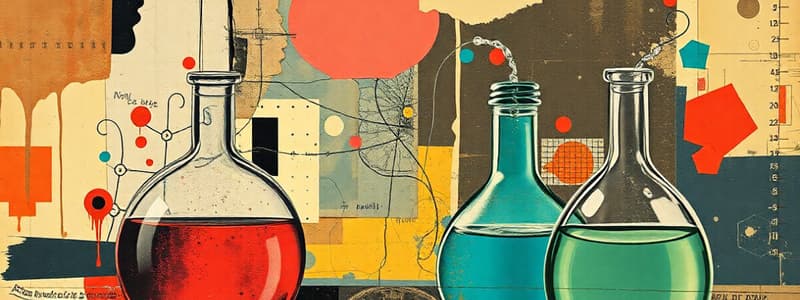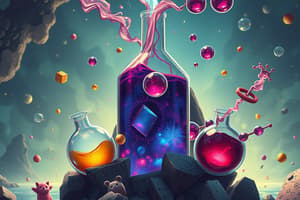Podcast
Questions and Answers
What defines a compound?
What defines a compound?
- A pure substance that cannot be broken down
- A combination of two or more elements chemically bonded (correct)
- A substance with a fixed shape and volume
- A material that has mass but no volume
Which particle arrangement characterizes a solid?
Which particle arrangement characterizes a solid?
- Particles have a fixed volume but no fixed shape
- Particles are tightly packed in a fixed shape (correct)
- Particles are close but can flow
- Particles are far apart and move freely
What is produced in a chemical reaction?
What is produced in a chemical reaction?
- Reactants
- Molecules
- Products (correct)
- Elements
Which type of bond involves the transfer of electrons?
Which type of bond involves the transfer of electrons?
What is the pH level of a neutral solution?
What is the pH level of a neutral solution?
In which reaction does a single compound break down into two or more products?
In which reaction does a single compound break down into two or more products?
What does the mole measure in chemistry?
What does the mole measure in chemistry?
Which reaction type results in the release of energy?
Which reaction type results in the release of energy?
Flashcards are hidden until you start studying
Study Notes
Basic Concepts of Chemistry
- Matter: Anything that has mass and takes up space.
- Element: A pure substance that cannot be broken down into simpler substances. Examples: Hydrogen (H), Oxygen (O).
- Compound: A substance formed when two or more elements chemically bond together. Example: Water (H₂O).
- Mixture: A combination of two or more substances that are not chemically bonded.
States of Matter
- Solid: Fixed shape and volume; particles tightly packed.
- Liquid: Fixed volume but no fixed shape; particles are close but can flow.
- Gas: No fixed shape or volume; particles are far apart and move freely.
Chemical Bonding
- Ionic Bonds: Formed by the transfer of electrons from one atom to another; results in oppositely charged ions.
- Covalent Bonds: Formed by the sharing of electrons between atoms.
- Metallic Bonds: Involves the pooling of electrons among metal atoms.
Chemical Reactions
- Reactants: Substances that undergo a change during a chemical reaction.
- Products: Substances formed as a result of a chemical reaction.
- Types of Reactions:
- Synthesis: Two or more reactants combine to form a single product.
- Decomposition: A single compound breaks down into two or more products.
- Single Replacement: One element replaces another in a compound.
- Double Replacement: Exchange of ions between two compounds.
The Periodic Table
- Groups (Columns): Elements in the same group have similar chemical properties. Example: Group 1 (Alkali Metals).
- Periods (Rows): Elements in the same period have the same number of electron shells.
- Metals, Nonmetals, Metalloids: Distinct categories based on physical and chemical properties.
Acids and Bases
- Acids: Substances that donate protons (H⁺) and produce hydronium ions (H₃O⁺) in solutions. Example: Hydrochloric acid (HCl).
- Bases: Substances that accept protons or produce hydroxide ions (OH⁻). Example: Sodium hydroxide (NaOH).
- pH Scale: Measures the acidity or basicity of a solution (0-14 range; <7 is acidic, >7 is basic).
Stoichiometry
- Mole: A unit that measures the amount of substance (6.022 x 10²³ particles).
- Molar Mass: The mass of one mole of a substance.
- Balanced Reactions: In chemical equations, the number of atoms must be the same on both sides.
Thermodynamics in Chemistry
- Exothermic Reactions: Release energy (usually as heat) into the surroundings.
- Endothermic Reactions: Absorb energy from the surroundings.
- Enthalpy (ΔH): A measure of heat content during a reaction.
Key Concepts of Organic Chemistry
- Hydrocarbons: Compounds composed only of hydrogen and carbon. Types include:
- Alkanes: Single bonds (saturated).
- Alkenes: At least one double bond.
- Alkynes: At least one triple bond.
- Functional Groups: Specific groups of atoms within molecules that determine the characteristics and chemical reactivity of the compounds. Examples: Hydroxyl (-OH), Carboxyl (-COOH).
Matter and Its Composition
- Anything that has mass and takes up space is considered matter.
- Elements are pure substances that cannot be broken down further. Examples include hydrogen (H) and oxygen (O).
- Compounds are formed when two or more elements chemically bond together, like water (H₂O).
- Mixtures are combinations of substances that are not chemically bonded.
States of Matter
- Solids have a fixed shape and volume with particles tightly packed.
- Liquids maintain a fixed volume but lack a fixed shape, with particles close together and able to flow.
- Gases have no fixed shape or volume, with particles far apart and moving freely.
Chemical Bonding
- Ionic bonds occur when electrons are transferred between atoms, resulting in oppositely charged ions.
- Covalent bonds involve the sharing of electrons between atoms.
- Metallic bonds occur when electrons are pooled between metal atoms.
Chemical Reactions
- Reactants are substances that undergo a change during a chemical reaction.
- Products are substances formed as a result of a chemical reaction.
- Synthesis reactions combine two or more reactants to form a single product.
- Decomposition reactions break down a single compound into two or more products.
- Single replacement reactions involve one element replacing another in a compound.
- Double replacement reactions exchange ions between two compounds.
The Periodic Table
- Groups (columns) on the periodic table contain elements with similar chemical properties. For example, Group 1 contains the Alkali Metals.
- Periods (rows) on the periodic table represent elements with the same number of electron shells.
- Elements are classified as metals, nonmetals, or metalloids based on their physical and chemical properties.
Acids and Bases
- Acids donate protons (H⁺) and produce hydronium ions (H₃O⁺) in solutions. An example is hydrochloric acid (HCl).
- Bases accept protons or produce hydroxide ions (OH⁻). Sodium hydroxide (NaOH) is an example.
- The pH scale measures acidity or basicity of a solution, ranging from 0 to 14, with 7 being neutral.
Stoichiometry
- The mole is a unit that measures the amount of substance, equivalent to 6.022 x 10²³ particles.
- Molar mass represents the mass of one mole of a substance.
- Balanced chemical equations ensure that the number of atoms of each element is the same on both sides of the reaction.
Thermodynamics in Chemistry
- Exothermic reactions release energy (often as heat) into their surroundings.
- Endothermic reactions absorb energy from their surroundings.
- Enthalpy (ΔH) measures the heat content change during a reaction.
Key Concepts of Organic Chemistry
- Hydrocarbons are compounds composed solely of hydrogen and carbon.
- Alkanes contain only single bonds and are considered saturated.
- Alkenes have at least one double bond.
- Alkynes have at least one triple bond.
- Functional groups are specific groups of atoms within molecules that determine the characteristics and chemical reactivity of compounds. Examples include the hydroxyl group (-OH) and carboxyl group (-COOH).
Studying That Suits You
Use AI to generate personalized quizzes and flashcards to suit your learning preferences.



